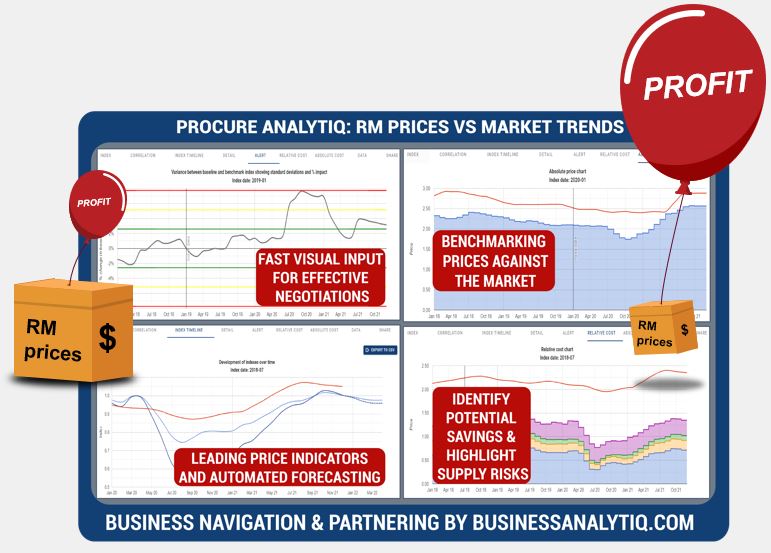Oxalic Acid price April 2024 and outlook (see chart below)
- North America:US$0.43/KG, -2.3% down
- Europe:US$0.44/KG, unchanged
- Northeast Asia:US$0.32/KG, unchanged
Business Analytiq assumes no responsibility or liability for any errors or omissions in the content of this site. The information contained in this site is provided on an “as is” basis with no guarantees of completeness, accuracy, usefulness, or timeliness.
Oxalic Acid price index
This post is a summary of the Oxalic Acid price index developments since 2017. The price developments are expressed as a price index in US$ prices converted at current FX rates, which are the FX rates applicable at the time the price was valid. Oxalic Acid price index developments are calculated from multiple separate sources of data to ensure statistical accuracy.
Further information on the Oxalic Acid price chart
What is Oxalic acid
Oxalic acid is a colorless, crystalline organic compound with the chemical formula H2C2O4. It is also known as ethanedioic acid. Oxalic acid is naturally found in many plants, such as spinach, rhubarb, and cocoa, and it can also be produced synthetically.
How is Oxalic acid produced
Oxalic acid can be produced by several methods, including natural extraction from plants, chemical synthesis, and microbial fermentation.
Natural extraction
Oxalic acid is naturally present in many plants, particularly in leafy greens such as spinach and rhubarb. It can be extracted from these sources by grinding the plant material, boiling it in water, and then filtering and purifying the resulting solution.
Chemical synthesis
Oxalic acid can also be produced synthetically by reacting ethylene glycol with nitric acid or by oxidizing carbohydrates such as glucose or sucrose with nitric acid. This process typically involves multiple steps and requires careful temperature and pH control.
Microbial fermentation
Oxalic acid can be produced by certain microorganisms, including fungi and bacteria. For example, the fungus Aspergillus niger is commonly used in the commercial production of oxalic acid by fermentation. In this process, the fungus is grown in a nutrient-rich medium containing a carbohydrate source such as glucose or molasses. As it grows, the fungus produces oxalic acid, which is then extracted and purified.
What drives the cost of Oxalic acid
The cost of oxalic acid can be influenced by several factors, including:
Production method
The production method used to produce oxalic acid can impact the cost. Natural extraction methods may be less expensive than chemical synthesis or microbial fermentation, depending on the availability and cost of plant sources.
Raw materials
The cost of the raw materials used to produce oxalic acid can also impact the overall cost. For example, the cost of ethylene glycol, which is used in some chemical synthesis methods, can be subject to fluctuations in the global market.
Energy costs
The cost of energy required to produce oxalic acid can also be a significant factor, particularly for methods that involve chemical synthesis or microbial fermentation. Energy costs can vary depending on the location and availability of energy sources.
Transportation and logistics
The cost of transporting and handling oxalic acid can also impact the overall cost, particularly for long-distance shipments or specialized handling requirements.
Market demand
The overall demand for oxalic acid can also influence the cost, particularly in industries such as pharmaceuticals, textiles, and metal processing that rely heavily on oxalic acid for their processes.
Therefore, the cost of oxalic acid can vary depending on the specific circumstances of its production and market demand.
What is Oxalic acid used for
Oxalic acid has a variety of industrial, commercial, and household uses, including:
Cleaning and stain removal
Oxalic acid is a powerful cleaning agent and is often used to remove rust stains from metal surfaces or bleach stains from fabrics.
Metal processing
Oxalic acid is used in some metal processing industries as a polishing agent, etching solution, or rust inhibitor.
Woodworking
Oxalic acid is used to remove stains or discoloration from wood surfaces, and is often used in combination with other wood bleach agents.
Pharmaceuticals
Oxalic acid is used in the production of some pharmaceuticals, including certain antibiotics and anti-cancer drugs.
Agriculture
Oxalic acid is sometimes used as a pesticide or herbicide, as it can be toxic to certain insects and plants.
Other industrial uses
Oxalic acid is used in a variety of other industrial applications, such as the production of certain dyes, ink, and photographic chemicals.
What types of Oxalic acid are there
There are two main types of oxalic acid:
Anhydrous oxalic acid
This is the pure form of oxalic acid that does not contain any water molecules. It is a white, crystalline powder that is highly soluble in water.
Dihydrate oxalic acid
This form of oxalic acid contains two water molecules per molecule of oxalic acid. It is also a white, crystalline powder, but is less soluble in water than anhydrous oxalic acid.
Both forms of oxalic acid have similar chemical properties and can be used for similar purposes. However, dihydrate oxalic acid is more commonly used in some applications, such as cleaning and stain removal, due to its lower solubility in water, which can make it easier to handle and apply.
What are the specific properties of Oxalic acid
Oxalic acid has several properties that make it suitable for industrial use, including:
Solubility
Oxalic acid is highly soluble in water, which makes it easy to dissolve and apply in various industrial processes. This property is particularly useful in applications such as cleaning and stain removal, where oxalic acid can be added to water to create a solution that can effectively remove stains and discolorations.
Acidity
Oxalic acid is a strong organic acid, with a pKa value of 1.27. This property makes it useful in many industrial applications where an acid is needed, such as metal processing or wood bleaching.
Reducing agent
Oxalic acid can act as a reducing agent in some chemical reactions, particularly in the presence of certain metal ions. This property is useful in some industrial applications, such as in the production of certain dyes or photographic chemicals.
Biodegradability
Oxalic acid is a naturally occurring organic acid that can be biodegraded by many microorganisms. This property makes it useful in some environmentally friendly applications, such as in certain agricultural or horticultural practices.
Cost-effectiveness
Oxalic acid is relatively inexpensive to produce, particularly when compared to some other organic acids with similar properties. This property makes it an attractive choice for many industrial applications where cost is a factor.
Overall, the combination of solubility, acidity, reducing power, biodegradability, and cost-effectiveness make oxalic acid a useful and versatile compound for many industrial applications.
Which industries is Oxalic acid used in
Oxalic acid is used in a wide range of industries, including:
Pharmaceuticals
Oxalic acid is used in the production of certain drugs and medicines, particularly in the synthesis of antibiotics and antiseptics.
Textiles
Oxalic acid is used as a bleaching agent in the textile industry, particularly for cotton and other natural fibers.
Metals and mining
Oxalic acid is used in the processing of metals, such as rare earth metals, to remove impurities and improve the purity and quality of the final product. It is also used in mining operations to leach metals from ores.
Cleaning and stain removal
Oxalic acid is a powerful cleaning agent that can effectively remove stains and discolorations from a wide range of surfaces, including wood, concrete, and metal.
Agriculture and horticulture
Oxalic acid is used as a pesticide and herbicide in some agricultural and horticultural practices, particularly in organic farming.
Photography
Oxalic acid is used in some photographic processes, particularly in the production of certain types of film and photographic paper.
Others
Oxalic acid is also used in a variety of other applications, such as in the production of certain dyes and pigments, as a reducing agent in some chemical reactions, and as a component of some electrolyte solutions.
How big is the global market for Oxalic acid
The global market for oxalic acid was valued at approximately USD 520 million in 2020, and is expected to reach USD 710 million by 2027, growing at a CAGR of 4.2% during the forecast period of 2021-2027, according to a report by Meticulous Research.
The major factors driving the growth of the oxalic acid market include its increasing use in various end-use industries, such as pharmaceuticals, textiles, and metal processing, and its growing popularity as an eco-friendly alternative to other chemical cleaning agents. In addition, the increasing demand for oxalic acid in emerging economies, particularly in the Asia-Pacific region, is also expected to fuel market growth in the coming years.
The Asia-Pacific region is the largest market for oxalic acid, accounting for over 40% of the global market share, due to the presence of a large number of end-use industries, particularly in China and India. Europe and North America are also significant markets for oxalic acid, driven by the demand from the pharmaceutical and metal processing industries.
Overall, the global market for oxalic acid is expected to continue growing in the coming years, driven by the increasing demand from various end-use industries and the growing popularity of oxalic acid as a cost-effective and eco-friendly alternative to other chemical agents.
Which countries produce the most Oxalic acid
China is currently the world’s largest producer of oxalic acid, accounting for the majority of global production. Other major producers of oxalic acid include India, Europe, and the United States.
In China, oxalic acid is primarily produced in the provinces of Henan, Jiangsu, and Shandong, where several large chemical companies have established production facilities. These companies benefit from China’s abundant supply of raw materials, particularly calcium carbonate, which is a key ingredient in oxalic acid production.
In India, oxalic acid is mainly produced by a few large chemical companies, primarily located in the western state of Gujarat. These companies use a combination of imported and domestically sourced raw materials to produce oxalic acid.
In Europe, oxalic acid is produced by several large chemical companies, particularly in Germany, France, and the UK. These companies typically produce oxalic acid as a byproduct of other chemical processes, such as the production of glyoxylic acid.
In the United States, oxalic acid is produced by a few large chemical companies, primarily located in the Midwest and the Northeast. These companies use a variety of raw materials, including corn cobs and wood chips, to produce oxalic acid.
Further information
- Wikipedia for general, history, production and usage information
- PubChem for chemistry and property information
Business Analytiq
BE THE FIRST TO SEE RISK AND OPPORTUNITY!
BusinessAnalytiq provides unlimited market trend data and an online tools to track market developments, key benchmarks & leading indicators.
BusinessAnalytiq leads to price visibility, better negotiations, easier budgeting and forecasting, lower raw material prices, and improved better internal and external communication. BusinessAnalytiq will decrease risk and higher profit.

Where does the data come from?
- The source of the data are exclusively public non-confidential sources. We have no access to primary data
- This the index trend of the price trend of the "product category" in general, and not a single specification of the product in particular
- The data is a combination of contract and spot pricing
- Our algorithms are set up to eliminate significant product mix impact on the reported price
- We combine public publications, import/export records, trading prices, company announcements, magazine articles, tweets, and other sources of ad-hoc public information.
- The chart shows the our best approximation of the market trend based on our algorithm interpretation of the signals
- For most indexes we have multiple sources and we focus on using statistically-correlated sources
- As a function of our automation, it is likely that recent trends will be adjusted as we discover more information. So, for example, the price trend for February 2024 will be first calculated in February 2024 and adjusted in March, April and May 2024.
- We will update the data trend as more information becomes available, and this means that recent trends will always be adjusted as we get more data available
- The algorithm will regularly revise our understanding of market trends, and indicated market trends may change
- The data is presented in US$. The UOM of measure is shown in the Index list table
- Our automated software and we do our best to create an accurate representation of the trend
Where does the data NOT come from?
- We do not purchase data from any other source and republish it.
- We will not purchase data from any other source and republish it
- We do not extrapolate trends, even for the forecast. We look for other market signals and leading indicators
What data should our company use?
- If you are making decisions driving significant share of profit, we always recommend that you buy data from the companies who invest in direct primary market access such as ICIS, amongst many others
- Our data, at best, represents an estimate of the market trend based on public information
- We have no direct access to the market, and we do not interview suppliers and customers
- Our automated analysis tools in the online software are set up to combine our data with other sources of data
- We do not recommend that you use our data for direct price mechanisms, as we may change and improve the data trends over time, including historical data
What does the quality indication in the main menu mean?
- Quality level A: Data is from a reliable and confirmed source
- Quality level B: Data is from multiple credible sources and there are no major statistical inconsistencies between them
- Quality level C: Data is from multiple credible sources and there are some statistical inconsistencies between them
- Quality level D: Data is from a single credible source, but we cannot verify the data
- Quality level E: Data is either:
- From a single source, which we consider reliable, but we cannot verify the data.
- From 2 or more sources which have some periods of contradicting trends.
- Quality level F: Data is from a single source which we consider indicatively correct, but the data is anecdotal and we cannot verify the data.
What are the disclaimers?
- We assume no responsibility or liability for any errors or omissions in the content of this site.
- The information is provided on an “as is” basis with no guarantee of completeness, accuracy, usefulness, fitness for purpose or timeliness.
- By their nature, outlooks are always uncertain
How often do we update the data?
- We aim to update the data series on the 9th and 24th of each month (but we do not always make it for each chart)
- The data for the current month and recent history are fine-tuned over time.
What are we doing to improve the data?
- We are continually improving our data collection and processing methods
- Pricing data will be updated from time to time as we improve the accuracy
- We are reviewing all data sources in the first half of 2024.
- There will be continuous fine-tuning of the trend and forecast algorithm as part of that.
- The key focus in 2024 is to add many additional indexes
How can i give feedback on the data or request for new indexes
- Feel free to contact us if you have a specific request. You can reach us via the Contact us page

